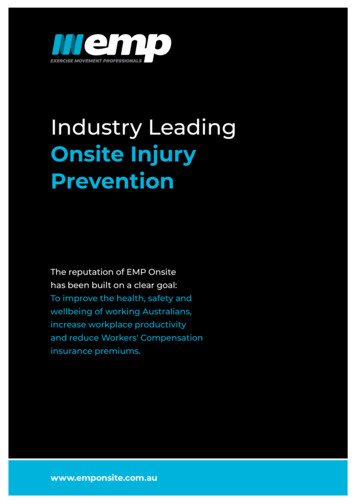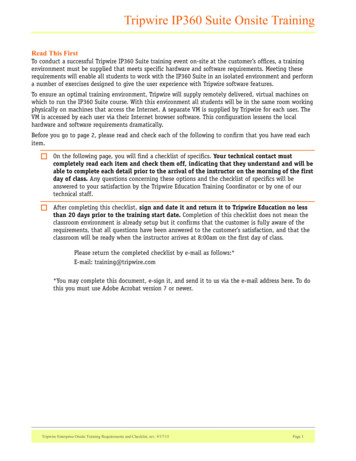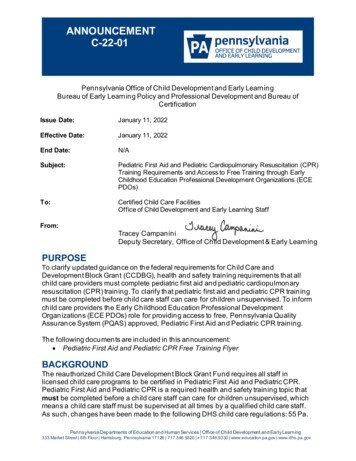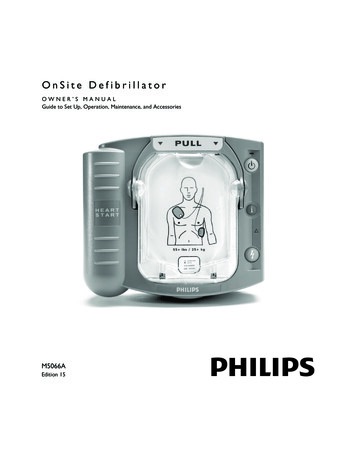
Transcription
Bespoke training in your lab.On your instruments.At a time that suits you.Onsite training from theCrawford Scientific experts
2017 - 2018 Onsite Training Course Portfolio» HPLC Fundamentals» HPLC Troubleshooting & Maintenance» HPLC Method Development» GC Fundamentals» GC Troubleshooting & Maintenance» GC Method Development» LC-MS For the Chromatographer» LC-MS Data Interpretation» GC-MS For the Chromatographer» GC-MS Data Interpretation» Introductory Statistics for Analytical Chemists» Advanced Statistics for Analytical Chemists» Analytical Method Validation» Meet the Team» Contact UsCrawford Scientific are a recognised provider of high quality training inanalytical science. Our onsite courses are designed to provide maximumimpact on student knowledge and effectiveness in the laboratory.Email our Training Team
HPLC FundamentalsThis one-day course introduces the fundamentally important concepts associated with HPLCanalysis including hardware basics, modes of analysis, basic troubleshooting, column chemistry,principles of ionisation and more.Suitable as a refresher for the more experienced chemist or as an invaluable introduction to thetechnique for those with limited experience, this course provides an invaluable insight into HPLCprinciples and practice.Course ContentsBasics of the Chromatographic Process Main retention mechanisms in HPLC Distribution constant Retention theory Model of the chromatographic processSample Preparation Protocols Principles Matrix elimination Liquid and Solid Phase ExtractionSeparation Mode / Retention Mechanisms Absorption (normal phase) Reverse phase Principals of ionisation (Ion SuppressionChromatography) Ion pairing Ion exchangeQuantitation Integration parameters System suitability testingInjectors and Columns Sample introduction Rheodyne injectors / auto-samplers Silica as a solid support Column & packing geometry Efficiency - the van Deemter &Knox equationsDetectors Choosing the right detector Operating principles Optimisation Typical operating conditions UV (Diode Array) / RI / FluorescenceMeasuring & OptimisingChromatographic Parameters Efficiency Capacity factor Selectivity Resolution Interdependence via theresolution equation
HPLC Troubleshooting & MaintenanceA logical approach to troubleshooting is explored using both the component (hardware based) andSymptomatic (chromatogram based) perspectives.Best practice for instrument maintenance and column handling are discussed to aid the user inprolonging the intervals between essential system maintenance.In-depth treatment of the causes of peak shape and baseline anomalies are fully covered, this courseis invaluable to anyone who wishes to gain further insight into the problems associated with HPLCanalysis.Course ContentsApproaches to Logical Troubleshooting System overview Component perspective Symptomatic perspective System maintenance records Symptoms / Causes / Diagnosis & SolutionComponent PerspectiveWhat to look for / what can go wrong with: Autosamplers Detectors: UV / RI / Fluorescence Solvent delivery systems & mobile phaseColumns Installation and conditioning Column chemistry Efficiency loss pH operating range / bleed Proper column management Loss of sensitivitySymptomatic Perspective - Baselines Baseline spikes Noisy baselines Cycling baselines Rising / falling baselinesSymptomatic Perspective - Peaks No peaks Fronting / tailing peaks Split peaks / shoulders Broad peaks Ghost peaks Retention stability Loss of sensitivity Correct integration methodsMaintenance Maintenance schedules Correct maintenance procedures for allsystem components Column maintenance
HPLC Method DevelopmentFor the experienced chromatographer, this course provides a step-by-step explanation of logicalHPLC method development.The course includes detailed discussion of the crucial aspects of method development with relevantexamples used to demonstrate theoretical principles and software based exercises to give a deeperunderstanding.Course ContentsObjectives Establishing method objectives Literature searching What is known? What needs to be known?Sample Preparation Sample clean up Analyte extraction SPE explained Mobile phase selection Optimising for sample type / applicationSystem Choices How to choose the appropriateinjector/detector Typical operating conditions Developing and optimisinginjection conditions Mobile phase flow & band broadening(Van Deemter) Modes of chromatographyChoosing a Column & Mobile Phase Choosing the correct phase Computer based tools for column choice Effects of column geometry Review of modern stationary phases Isocratic vs. Gradient operation Theory & development of eluent gradientsOptimisation Strategies Capacity factor, Efficiency,Resolution, Selectivity Resolution Equation Step-by-step guide for logicalmethod development Example method developmentsQuantitation & System Characterisation Single and multi-level calibration Internal standards System suitability testing Introduction to validation
GC FundamentalsFor the less experienced chromatographer or those wishing to update their skills, this course coversthe fundamentally important concepts in modern GC analysis.Basics of the chromatographic process, sample preparation, inlet systems, column and detectorselection are important topics covered to give the participant a thorough grounding in thetechnique. Instrument hardware is also covered with basic troubleshooting and maintenance tipsas well as an introduction to chromatographic optimisation.Course ContentsBasics of the Chromatographic Process Retention mechanisms in GC Temperature/retention relationships Column theory Stationary phase chemistriesSample Preparation Protocols Principles Matrix elimination Solvent considerations Liquid and Solid Phase ExtractionSample IntroductionOperating principlesTypical operating conditionsOptimisationSplit / splitlessCool on-columnHeadspace (on request) Columns and Temperature programming Choosing the right phase Column geometries explained Phase types Temperature effects Band Broadening (van Deemter& Golay treatment) Isothermal vs. gradient operation Detectors Choosing the right detector Operating principles and Optimisation Typical operating conditions FID / ECD / GC-MSeMeasuring & OptimisingChromatographic Parameters Efficiency Capacity factor Selectivity Resolution Interdependence via theresolution equation
GC Troubleshooting & MaintenanceA logical approach to troubleshooting is explored using both the component (hardware based) andsymptomatic (chromatogram based) perspectives.Best practice for instrument maintenance and column handling, as well as, routines for cleaningand deactivating inlet and detection systems are discussed.The causes of peak shape and baseline anomalies are fully covered, this course is invaluable toanyone who wishes to gain further insight into the problems associated with GC analysis.Course ContentsApproaches to Logical Troubleshooting Logical troubleshooting System overview Component perspective Symptomatic perspective System maintenance records Symptom / Causes / Diagnosis & SolutionComponent PerspectiveWhat to look for / what can go wrong with: Injectors: on-column / split - splitless / largevolume Detectors: FID / ECD / NPD / FPD Temperature and pressure controlColumns Installation and conditioning Operating principles Optimisation Operating range / bleed Band broadeningSymptomatic Perspective - Baselines Baseline spikes Noisy baselines Cycling baselines Rising / falling baselinesSymptomatic Perspective - Peaks No peaks Fronting / tailing peaks Split peaks / shoulders Broad shoulders Ghost shoulders Retention stability Solvent incompatibility Loss of sensitivityMaintenance Maintenance schedules Correct maintenance procedures injectorsand detectors
GC Method DevelopmentFor the experienced chromatographer, this course provides a step-by-step approach to methoddevelopment. The course includes all of the crucial aspects of method development including;Column dimensions, phase type, inlet type and operating conditions, detector settings andoptimisation along with sample preparation regimes.Each aspect is discussed in detail supplemented by a host of real world separation examples andtutorial exercises to aid understanding.Course ContentsObjectives Establishing method objectives Literature searching What is known? What needs to be known?Sample Preparation Sample clean up Analyte extraction Solvent selection Optimising for sample type / applicationInlet, and Flow Rate Parameters The effect of split ratio of peak shape andquantitative Accuracy Investigating oven initial temperature Conversion into a splitless method Optimising purge on time Carrier gas choice and flow rateoptimisation (van Deemter & Golaytreatment)Choosing a Column & Temperature Choosing the correct phase Effects of column geometry Solute stationary phase interactions Isothermal vs. Gradient operation Theory and development ofTemperature gradientsOptimisation Strategies Measuring and Optimising Capacity factor, Efficiency,Resolution, Selectivity Resolution equation Developing effective methods Example method developmentsPutting it all together! Developing a method for theseparation of a complex mixtureof compounds from scratch.
LC-MS For the ChromatographerThe Atmospheric Pressure Interface (API) is the core element to the course with the principles ofoperation, limitations and applicability fully explored.The course covers ion suppression, the use of Electrospray or APCI and MS-MS data acquisitionmodes. Optimisation of interface and mass filter settings and how to best utilise reduced dimensionLC to speed up sample throughput will be discussed.All popular interface types and mass analysing equipment (Quadrupole, TOF, Ion Trap etc.) will becomprehensively covered.Course ContentsIntroduction – Fundamentals Review Commonly used terms and concepts Atmospheric Pressure Ionsationmechanisms of ESI / APCI / APPI API - source design LC-MS Eluent design – solvents buffers andadditives API (ESI) interface optimisationMass Analysers Quadrupole mass analysers Time of flight mass analysers Ion trap mass analysersMass Accuracy and Resolution Calibration of mass axis Mass accuracy / resolution Advantages of various analyser types Tuning the mass analyser (sensitivity vsresolution)Scan Functions LC-MS data acquisition modes (sensitivityvs specificity) Scanning vs SIM Singly & multiply charged species Cone voltage fragmentation Up-front CIDLC-MS/MS Data Acquisition Modes Product ion scanning precursor Ion scanning Constant neutral loss Data dependant scanning Introduction to MS interpretation Product ion scanning Choosing precursor ions Establishing MRM method parameters Constant neutral loss experiments ofionisable compounds from scratch
LC-MS Data InterpretationAttendees on this courses will benefit from a greater understanding of how to interpret the massspectra produced by Electrospray Ionisation (ESI) and Atmospheric Pressure Chemical Ionisation(APCI).This course will give the delegate increased confidence and understanding of: Mass spectral data analysis Structural elucidation Product ion generation by Collision Induced Dissociation (CID) characterization Advantages and limitations of common mass analyser typesCourse ContentsInterpretation of low molecular weight compound mass spectra considers the importance of: Understanding isotope patterns and their relative signal responses in assigning elementalcomposition and confirming chemical structure Understanding how common characteristic production fragmentation series are producedthrough atomic electronic effects A mechanistic understanding of the inductive and alpha cleavage How CID fragmentation can be invaluable for sample identification purposes through firstprinciples interpretation and database searching Inclusion of peptide sequencing by tandem mass spectrometry as requiredInterpretation of high molecular weight compound mass spectra considers the importance of: When to report monoisotopic mass or average mass The process of deconvolution of an ESI multiply charged ion series to derive the molecularweight of a compoundFurther Explanation of the formation of common adduct ions under different solvent and bufferconditions Solution and source compound dimerisation effects The process of data dependent acquisition and modern detector systems Comprehensive set of tutor-led tutorial questions to facilitate the learning process
GC-MS For the ChromatographerA course designed to highlight the powerful possibilities of GC analysis with spectral detection.Tuning and tune reports will be explained and instruction given in the use of tune reports as apowerful diagnostic tool.The functionality of the MS will be discussed in detail including principles of the quadrupole massfilter. Ionisiation will be thoroughly investigated and practically optimised along with cleaningprinciples and regimes being explained and demonstrated.Course ContentsChromatographic Considerations Sample preparation Column configurations for GC-MS Sample loading and stationary phasechoice Flow rate considerationsSample Introduction The Transfer Line Flow splitting The ion source explained Modes of ionisation Electron impact / chemically inducedionisation examples and fragmentationMS Hardware Why use vacuum? Controlling and monitoring vacuum Quadrupole mass analysis explained Ion traps explainedDetector Systems Electron multipliers and detectorelectronics Matthieu stability diagrams X-ray lens and high energy dynodes AMU gain and offset Spectral resolutionTuning and Calibration Purpose of tuning Tuning compounds Explanation of auto-tune voltages Troubleshooting from the auto-tune User tuning and voltage rampingQuantitation Scan & SIM modes High sensitivity data acquisition
GC-MS Data InterpretationThis course provides the basic knowledge required for the interpretation of unknown spectra.Starting from the first principles, it introduces the fundamental chemistry of mass spectrometryand builds up to an examination of the most frequently encountered fragmentation patterns.This course is not instrument-specific and is suitable for anyone involved in mass spectrometry.A good working knowledge of the technique is required and attendance on our “GC/MS for thechromatographer” course is recommend prior to attendance on this course.Course ContentsBasic Chemistry Review of the chemistry of ions, electronsand radicals and isotopes vital tounderstanding of molecular fragmentationand ionisation The principles of isotopic normalisationPrinciples of Ionisation Techniques and impact on ionisation andfragmentation of Electron Impact (EI)and Chemically Induced (CI) ionisationmechanismsFragmentation Mechanisms Homo and heterolytic fission Alpha cleavage Inductive cleavage McLafferty rearrangement and orthoeffects Retro Diels-Alder reactionsInterpretation Rules General appearance Isoptopic abundances Isoptopic normalisation Common ion series Rings and double bonds The nitrogen rule Logical (Illogical) neutral molecular losses Logical (Illogical) neutral fragment losses Ion stabilityInterpretation Practice At all points during the course, practicespectra are given to highlight and allowthe student to learn the principles underinvestigation The course ends with practice exerciseson several spectra to confirm overallunderstanding
Introductory Statistics for Analytical ChemistsThis is a one day introductory course to the fundamental of statistics, relevant to all professionals inthe analytical sciences, life sciences and related fields.Course ContentsIntroduction Analytical problems Errors in quantitative analysis Random and systematic errors Accuracy, repeatability, reproducibility Standard reference materialsStatistical Measures Mean and standard deviation Variance and coefficient of variationNormal (Gaussian) Distribution Sampling distributions Confidence limits Significant figures Propagation of errorsSignificance Tests Null hypothesis, type I and type II errors Comparison of x and μ / Comparison of x1and x2 t-tests / F-tests One-sided and two-sided tests Outliers Analysis of variance (ANOVA) Fixed effects and random effects Comparison of several meansRegression and Correlation Calibration graphs / correlation coefficient Regression of y on x / errors in theregression line Calculation of a concentration Limit of detection Standard additions Outliers in regression Weighted regression lines
Advanced Statistics for Analytical ChemistsThis course is designed for scientists involved in experimental design, decision making and processoptimisation.The course shows how to use analysis of variance, randomisation and manipulation of controllablevariables to reduce variability, time and cost of design and development.Course ContentsQuality Control Methods Shewhart charts for mean values Shewhart charts for ranges Warning and action lines Cusum charts Zone control charts (J-charts) Specification settingExperimental Design and Optimisation Introduction Randomisation and blocking Two-way ANOVA Latin squares and other designs Simulated annealing Interactions Factorial versus one-at-a-time design Factorial design and optimisation Optimisation: basic principles andunivariate methods Optimisation using the alternatingvariable search method The method of steepest ascent Simplex optimisationThe Multivariate Analysis Introduction Initial analysis Principal component analysis Cluster analysis Discriminant analysis K-nearest neighbour method Disjoint class modelling Regression methods Multiple linear regression (MLR) Principal components regression (PCR) Partial least squares (PLS) regression Artificial neural networks
Analytical Method ValidationThis one day course covers all of the basics required to produce an analytical method validationprotocol, implement the validation studies and report to FDA standards.Analytical Best Practices will also be discussed and described and statistical treatments introduced.Course ContentsValidation Parameters Selectivity (Specificity) Linearity Accuracy (Trueness) Precision Sensitivity Robustness (including experimental designand statistical analysis)Experimental Design for Analytical MethodValidation ANOVA, Plackett-Burman, full factorialmethods etc. Statistical Methods and Testsfor Validation When and how to use t-tests / f-tests toprovide rigour to validation results Overview of Equipment ValidationThe following topics will be considered foreach of the major validation parameters Definitions Applicability ICH guidelines Eurachem guidelines ISO / IUPAC guidelines Important Comments and Considerations Procedure Statistical Analysis (where applicable) Validation Protocol Statements andReporting Conclusions Workshop / Tutorial Exercise (whereapplicable)
Meet the Training TeamClaire PatersonTraining ManagerHPLC method development, validation, troubleshooting,documentation and laboratory processes.Colin TowersTraining and Technical ConsultantMethod development, validation, routine analysis andtroubleshooting in LC, LC-MS/MS, GC, GC-MS and SPE.Amy ClaydonTraining and Technical ConsultantProteomics, HPLC and LC-MS.Josep Miquel SerretTraining and Technical ConsultantHPLC and GC, LC-MS and GC-MS method development.Contact UsEmail our Training TeamPhone:UK : 44 (0) 1357 522 961Website: http://www.crawfordscientific.com
HPLC Troubleshooting & Maintenance A logical approach to troubleshooting is explored using both the component (hardware based) and Symptomatic (chromatogram based) perspectives. Best practice for instrument maintenance and column handling are discussed to aid the user in prolonging the intervals between essential system maintenance.











